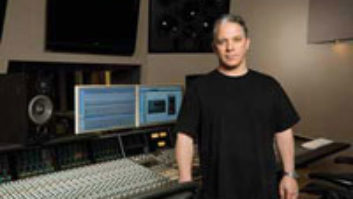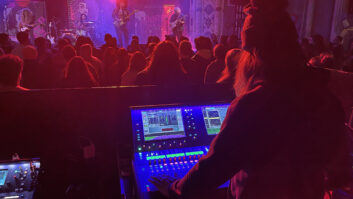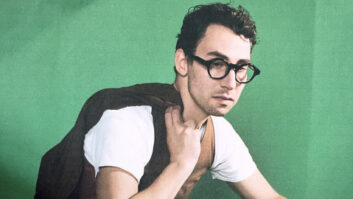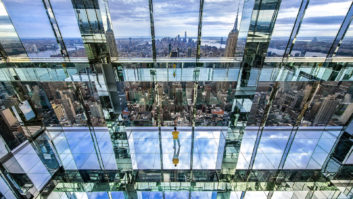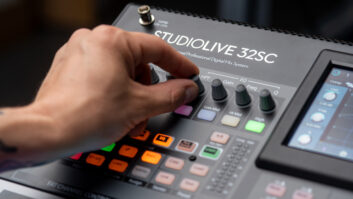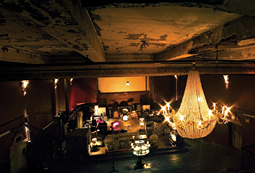
Mood lighting enhances the musical atmosphere at The Rumor Mill.
Photo: Brandon Ralph
Many of the world’s great studios are meticulously designed with the latest that acoustical science and architecture has to offer — and sometimes studios just seem to design themselves.
Case in point: The Rumor Mill on Manhattan’s Lower East Side is a mind-blowing, private musical environment that must be experienced to be understood. A cavernous 10,000-square-foot space with 50-foot ceilings, the facility was founded by multi-instrumentalist J. Ralph in 2001 to support his adventures in music for film, TV, commercials and, most importantly, wholly uninhibited audio explorations of The Third Kind.
Once you step into the main chamber of this ex-vaudeville theater from the turn of the last century, there’s no going back: You have teleported to a land that time forgot, discreetly wired to record any and all sounds you might make into either Pro Tools HD or Ralph’s vintage tape machines. “There’s a tremendous focus on lighting, with a very definitive concept and layout,” says Ralph. “There are pools of light everywhere, with more focused light for writing and playing different instruments. We have a cast-iron J. W. Fisk aquarium from 1840, lots of couches, oddities from around the world and countless instruments from every decade of music, including Duke Ellington’s Bluthner piano. There are things that will trigger your eyes or your ears so that you want to embrace, watch, touch and play everything.”
Although the space has been conducive to recording original music for such clients as Toyota, Nike, Coca-Cola and Volkswagen; the recent award-winning documentary Man on Wire; and much more, Ralph maintains that he is much more interested in The Rumor Mill’s role as an incubator for exciting new artists and orchestral recordings. “For me, the biggest enjoyment is recording sound, whether it’s a fishtank, a voice, footsteps or an orchestra,” he says.
Although the inspiring hangar-like room itself is unquestionably Ralph’s most valued piece of equipment, he has worked some other key pieces of gear into the space. “We have rare reverbs like the AKG BX-20; microphones like the RCA 44 BXs, the Neumann KM 64s and Telefunken U47; and the original BCM10 from Bearsville. We have API outboard, an RCA BA-6A limiting amplifier, which is crucial, a lot of the Purple Audio stuff, but the main things we’re using are the Neve 1073s, the AKG 414 TLIIs and the U47. We also use Digidesign D-Verb: It’s so gritty and full of character. The Vienna Symphonic Orchestral Library is essential to most things we write and produce.
“I work on everything with my partner, Arthur Pingrey. We have been playing together for over 10 years and we each bring something different to a recording. We also have a long-standing relationship with Bob Power, who is one of the most musical and talented producers on Earth.”
“Surrounded by all kinds of instruments, an arsenal of vintage recording equipment and thousands of records, you can really feel the history,” Ralph says. “It’s sensory overload, but with love and welcoming, and it’s so freeing that you’re left with just your own thoughts and infinite possibilities.”
Meanwhile just off of Fifth Avenue in a townhouse on the Teen Streets is a much smaller room called Candyland with an equally expansive sense of freedom. The founder/studio designer is an ultra-elite trumpet player named Michael Leonhart (www.myspace.com/michaelleonhart).
The product of a musical family, Leonhart was a Grammy Award-winner at age 17 and was performing and recording with Steely Dan in his early 20s. Now he spends a big chunk of his time in this apartment with 15-foot-high ceilings, a skylight and a location on a quiet but central Manhattan block that manages to feel far away from it all.
Candyland offers its own opportunities for recording that is as clean, dirty or experimental as you want to be, an outlook that’s readily apparent on his latest release, Hotel Music, out on iTunes and 200 limited-edition hand-painted vinyl sleeves. “I said early on that I’m not going to do what’s out of my range — my strength will be knowing what my weaknesses are and embracing that,” says Leonhart, who readily acknowledges that recording a full drum kit is not going to happen in this residential hideaway with standard-issue walls. “So after a Steely Dan tour, I got a pair of Mackie HR 824 near-field monitors, a Neumann U87 and a Universal Audio M-610 tube preamp, and I started chipping away.”
In addition to the songwriters, instrumental specialists and vocalists who work with Leonhart, the star of Candyland is the instruments and effects that line every inch of the walls and floors. “It’s a collection that gets loved and used,” says Leonhart. “There are 17 guitars, eight basses, one sitar, one electric sitar and 60 pedals. I have nine file cabinets divided into categories like toy instruments and serious percussion, an alligator glockenspiel, a bass melodica on loan from Donald Fagen, an MPC 3000 and two Wurlitzers that aren’t even mine but they sort of live here.
“A studio designer friend of mine came in, and said, ‘It’s funny, but with all these instruments on the wall, you’ve created a nice sense of diffusion.’ Actually, part of it comes from laziness and that I never tried to clean it up. The other part of it is, don’t do it unless you’re really going to do it 100 percent.”
Send N.Y. Metro news to [email protected].

